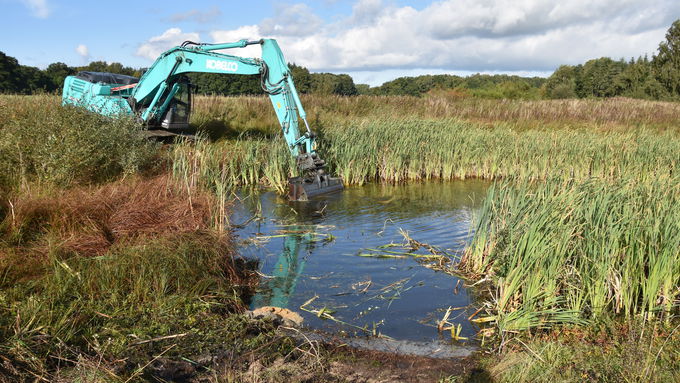Small water-body before restoration. The excavator gets down to work: In order to be able provide spawning habitat to amphibians like the common spadefoot again, this small water-body is partially desludged. © Frank Apffelstaedt, Naturschutzring Dümmer
main content
Project of the month
#11/2020 UPGRADING OF HABITATS FOR LOCAL AMPHIBIAN POPULATIONS IN THE DISTRICT OF VECHTA
BINGO and LIFE IP – Co-operation for Amphibians in the Hunte Floodplain near Goldenstedt
To upgrade and restore habitats for amphibians is the aim of a current species protection project of the ‘Naturschutzring Dümmer’ in the Hunte floodplain near Goldenstedt in the district of Vechta – a project supported by the Bingo Environmental Foundation of Lower Saxony and the state of Lower Saxony.
The Bingo Environmental Foundation of Lower Saxony has been supporting projects in the field of biodiversity and habitat networks for more than 30 years. In this context, the foundation supports NGOs by covering 85 percent of the costs of an entire project (including personnel costs), if the project areas are not located within Natura 2000 sites. However, for many potential applicants, the remaining 15 percent is a financial obstacle to submit a project. With the support of the LIFE IP Atlantic Region DE, however, for a few selected BINGO projects in Lower Saxony, 100 percent of financing can be achieved. This is made possible by the fact that the Lower Saxony Ministry of the Environment has agreed to finance the remaining own contribution if the LIFE Integrated Project is involved. The LIFE IP team then supports the projects during planning and implementation and is in contact with the stakeholders. These are usually already known partners of the LIFE IP.
This special constellation first arose in March 2019 in the BINGO project of ‘Naturschutzring Dümmer’ "Promotion of amphibian populations in the Hunte floodplain near Goldenstedt". The project is located in the Hunte floodplain between the villages of Barnstorf and Goldenstedt-Einen. Since the 1990s, the district of Vechta has acquired there an area of about 175 hectares as part of a nature conservation project to restore the Hunte floodplain, creating some 90 small water-bodies of varying shapes and sizes. Because of progressive succession, the suitability of many of these small water-bodies for the reproduction of amphibians has been restricted in the meantime. The initiation of the BINGO project by ‘Naturschutzring Dümmer’ was therefore expressly welcomed by the district of Vechta and the implementation was supported professionally by the Lower Nature Conservation Authority.
The restoration of water-bodies in this area then became part of the BINGO project in 2019. The areas are located outside Natura 2000 sites in the protected landscape area ‘Hunteaue’. The overall objective was to stabilise the populations of the natterjack toad (Bufo calamita) and in particular the common spadefoot (Pelobates fuscus) in this region by upgrading and connecting habitats and to allow for the repopulation of these species to the project area in which they had been native previously.
As a basis for the planned measures, the project first carried out an extensive study of the occurrence of amphibian species in water-bodies potentially suitable for the target species, as well as eDNA sampling. No occurrence of the common spadefoot was detected in the project area along the river Hunte. However, the presence of the species was confirmed within a radius of 2-4 km. Accordingly, a potential analysis is now to assess the extent to which natural settlement is possible from the surrounding occurrences or whether controlled reintroduction in accordance with the IUCN guidelines is conceivable in the future.
In November 2020, the desludging of about 35 small water-bodies was completed. The removal of shading woody plants from these and other water-bodies had already been completed at the beginning of the year. Partial treatment has ensured that structures such as reed beds or solitary groups of bushes were preserved for small birds, such as reed warblers or reed buntings. In addition, this has also ensured that underwater and floating leaf vegetation is still present and can be used by common spadefoots and other amphibians for spawning and dragonflies for egg deposition. The project will end in spring 2021 and further sites for stepping stone biotopes might still be identified.
‘Naturschutzring Dümmer’ has already been involved as a local partner in another LIFE IP action: In 2018/19, an action for the conservation and development of habitats for the natterjack toad (Bufo calamita) had been implemented together with the district of Vechta (action C71 on the top of the Geest between Vechta and Damme). ‘Naturschutzring Dümmer’ took over the mapping of 13 areas as well as the development of concrete proposals for these sites as well as the ecological construction supervision. The focus here was also on the restoration and creation of suitable small water-bodies.
Overall, BINGO project of the ‘Naturschutzring Dümmer’ has allowed for a restoration of complex of water-bodies with optimal conditions for amphibians in the Hunte floodplain near Goldenstedt and to establish an essential data basis, particularly for future planning with regard to the return of the common spadefoot to this project area.





